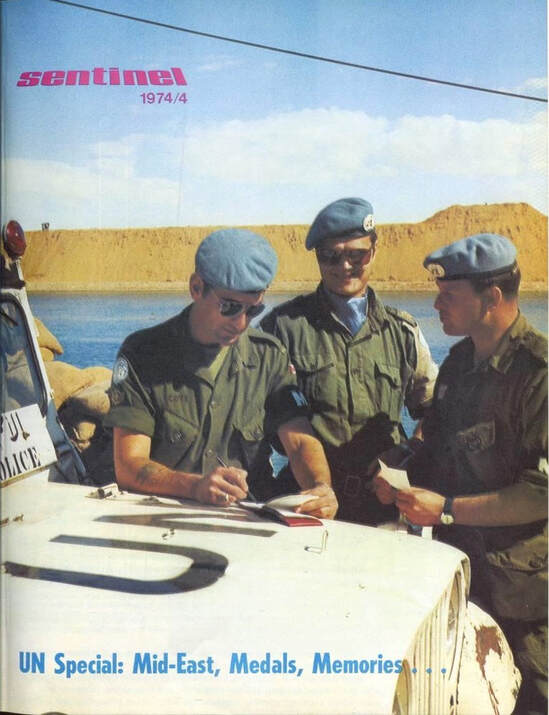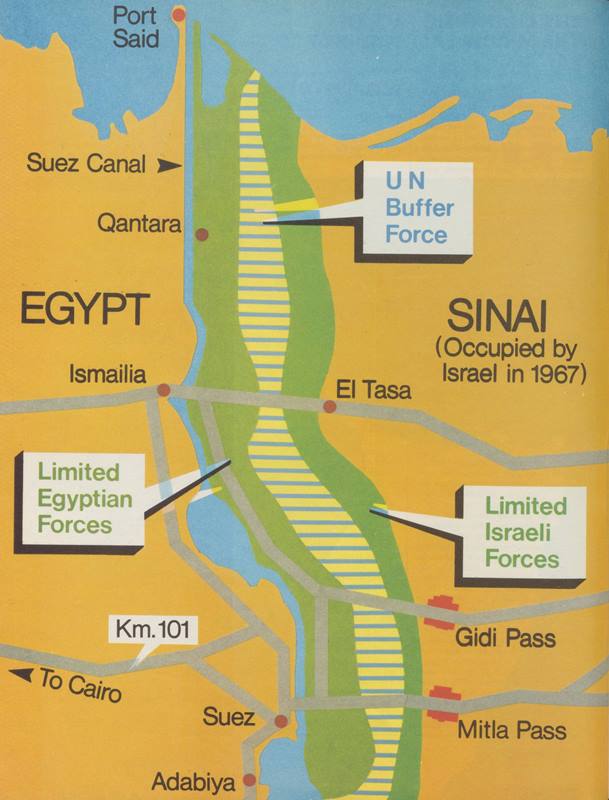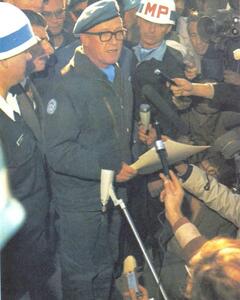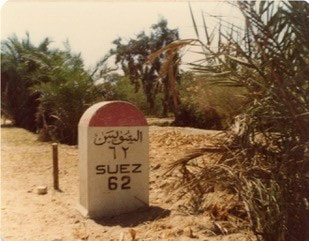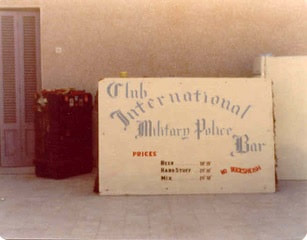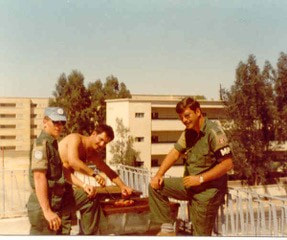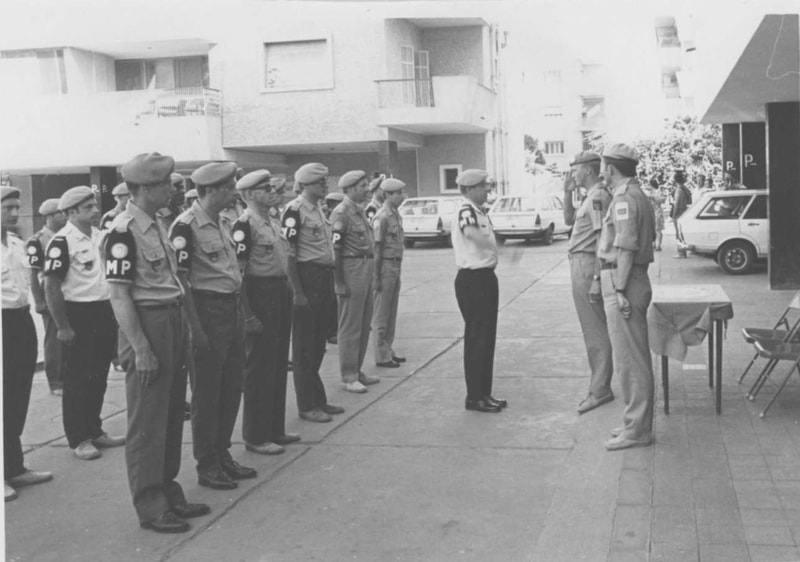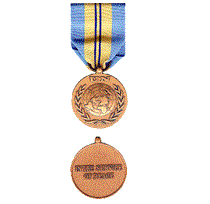Looking Back: UNEF II Military Police
By Lieutenant-Colonel Paul Thobo-Carlsen (Retired), CMPA Director of History & Heritage.
|
The cover of the 1974/4 edition of Sentinel, the magazine of the Canadian Forces, featured three members from the military police company of the second United Nations Emergency Force (now known as UNEF II).[1] The original UNEF mission, which lasted from 1956 to 1967, was the UN's response to the Suez Crisis and featured the first use of an international military peacekeeping force. Canadian External Affairs Minister (and later Prime Minister) Lester B. Pearson developed the idea for this UN-backed force, for which he subsequently won the 1957 Nobel Peace Prize.
UNEF II was established in October 1973 to supervise a ceasefire between warring parties after the 1973 Arab-Israeli War (also know as the Yom Kippur War). Further agreements in 1974 and 1975 made UNEF II responsible for supervising the redeployment of Egyptian and Isreali forces and controlling a buffer zone between them. Canada's main contributions throughout the life of the the mission were in the areas of air transport, logistics, communications and military police support.
Captain Tom Haney (pictured opposite, far right) arrived in Cairo in late October 1973 as officer-in-charge of the Canadian Contingent MP Detachment.[2] Master Warrant Officer John Watt accompanied him as the Detachment Sergeant-Major. The Canadian troops were initially accommodated at a former racetrack in the Helopolis suburb northwest of Cairo, which came to be known as Camp Shams. Within a short period the camp population swelled as many thousands of troops arrived from the initial twelve contributing counties (Austria, Canada, Finland, Ghana, Indonesia, Ireland, Nepal, Panama, Peru, Poland, Senegal and Sweden).[3] The support troops, including military police, remained in the Cairo area while the infantry units moved up to the ceasefire line after shaking themselves out. According to Tom, conditions at Camp Shams were primitive and amenities few.
It soon became apparent that having numerous small MP elements for each national contingent was inadequate, so by November 1973 it was decided to form a UN Military Police Company as had been done during the first UNEF mission and later in Cyprus. Capt Haney became the Company Operations Officer, working under a Finnish Company Commander and a Polish Deputy Commander. MWO Watt became the Company Sergeant-Major. Three Canadians remained as national contingent MPs, while the rest were integrated into the UN MP Coy that eventually numbered around 120 all ranks. The UN MPs soon set about doing route reconnaissances and setting up detachments in locations including Cairo, Ismailia, El Arish, Alexandria, Jerusalem and Tel Aviv. A small Special Investigation Detachment (SID) was also formed in Cairo, and later relocated to Ismailia.
The Canadian MPs were highly trained and motivated, and showed great initiative within the UN MP Coy. As Tom Haney recalls, it was a fabulously interesting and exciting time for all involved.
By the end of February 1974, UNEF II was up to its maximum strength of 6,973 troops, with Canada providing the largest single contingent of 1,097. The Canadian Armed Forces named its contribution Operation DANACA. Poland had the second largest contingent with 822 personnel. UNEF II troop levels began to decline later in 1974 after some troops were transferred to the United Nations Disengagement Observer Force (UNDOF) in the Golan Heights, and the numbers dropped further in 1975 when the contingents from Ireland, Nepal and Panama departed at the request of their governments.[4] By October 1975, Canada was still the largest troop contributor with 866 personnel out of total of 3,987.[5]
|
Acting Sergeant Larry Pace remembers this photo being taken on 3 February 1974 at Observation Post LIMA on the west bank of Suez Canal, which was blocked at the time. Larry commanded the MP section that Cpl Jerry Cote and SSgt Marko Mikkola were part of. The sand berm in the background, from the Sinai Desert, was bulldozed by the Isrealis to provide better observation during the 1967 Six day War. It was named the Bar-Lev Line after the late Israeli Defence Force General Haim Bar-Lev. The ceasefire agreement following the recent Yom Kippur War stipulated that both the Isrealis and Egyptians were to withdraw from positions they had seized. The UN would take over the positions from either side, wait until all occupying troops were cleared out, and then call the other side's soldiers in. This was done to avoid any direct contact between the belligerents. Tom Haney was issuing an operations order to this MP jeep team when the picture was taken. Tom notes that mission timings and the location of minefields were critical aspects of his ops briefing. Larry Pace recalls that these operations occurred weekly, every Monday, for six weeks. After each handover the UN MPs were required to escort Egyptian Engineers with dump-trucks behind Israeli lines to pick up their dead.
The photo above (right) was taken immediately following disengagement talks which took place on the front lines at Kilometer 101 on the Cairo-to-Suez Road. A Finnish infantry platoon surrounded the tent where these discussions took place and UN MP personnel provided entry control. Capt Tom Haney (left side, facing the general) was charged with ensuring the UN general's personnel safety during this event. A/Sgt Larry Pace (right side, facing camera) had minutes earlier dealt with a sub-machine being aimed at his stomach be a nervous bodyguard of the Egyptian general at the talks. With the clarity of hindsight, Tom now admits how unimpressive these lightly armed UN troops probably looked sandwiched between two belligerent armoured corps facing down on each other only 500 meter apart!
|
Camp El Gala—located at the airfield in Ismailia, Egypt—became the main Canadian Contingent operating location and was where the nation contingent MPs were quartered. Over time the camp was built-up with a number of amenities including multiple sports facilities (tennis and squash courts, ball diamond, volleyball court and weight room), messes with swimming pool and sauna facilities, and a complete radio station (CFME). Evening entertainment included movies and taped TV programs.[6]
The Canadian MPs attached to the UNEF II MP Coy were housed separately at the United Nations headquarters compound in Ismailia, except while serving on rotation to one of the outlying UN MP Dets. So the UN MPs could relax and decompress among their own, they were permitted to operate a wet bar in a rooftop area above their quarters which they named Club International. The UN MP accommodations, which were quire spacious and well-equipped compared to those at the Canadian camp at El Gala, overlooked an open area that was used weekly to show movies and live entertainment. One such live performance featured the Swedish pop group ABBA.
The Camp David Accords in September 1978 set the stage for a Middle East Peace Treaty signed in March 1979, which in turn led to the close-out of UNEF II beginning in late-July of 1979. The last Canadian troops withdrew from the region on 31 October 1979, ending Op DANACA.[7]
UNEF II was the first peacekeeping operation in which the Canadian Armed Forces fully integrated women. They served in a multitude of support roles, including nurses, pharmacists, administration officers, supply technicians, and cooks.[8] However, no female MPs served with UNEF II since the final Canadian military restrictions on women in MP field units was not lifted until 1978, shortly before the mission ended.
Retired MP Master Warrant Officer Gary Stojak shared some recollections of his UNEF II tour with the CMPA. During his rotation, from July to December 1976, Captain Alan Bell-Chambers and Captain Tony Cannons[9] were the two senior MP Branch members in theater and Canadian MP Marcel Whissel was the NCO-in-charge of the SID. Gary spent two months with the SID in Ismialia, one and a half months at the Jerusalem Det, two and a half months back at SID, and finally one month on patrols in Ismailia. At that point in the mission Gary recalls the UN MP Coy being organized at follows:
- MP Coy HQ, MP Det and SID in Ismailia (Egypt),
- MP Det in Cairo (Egypt),
- MP Det in Suez City (Egypt),
- MP Det in Alexandria (Egypt),
- MP Det in Jerusalem (Isreal), and
- MP Det in Eliat (Isreal).
The following newspaper article provides further details from Tony Cannons about UNEF II and related military police duties in the 1976-77 time frame.
Retired Major Wayne Kendall (a long-time member of the CMPA executive) served as Operations Officer with the UNEF II MP Coy from May to November 1978, and remembers the tour as one of the best postings of his 30-year career. During Wayne's time in theater the company comprised 76 military personnel and two civilians from six of the seven nations still participating in the mission: Canada, Finland, Ghana, Indonesia, Poland and Sweden. The Commanding Officer position was by then being filled by a Swedish Major, but the Deputy Commanding Officer position was still allocated to a Polish Captain and the Sgt-Maj position to a Canadian CWO. Canadian personnel filling MP Coy positions in Ismailia during this period included:
- Ops O - Capt A.W. Kendall
- Coy Sgt-Maj - CWO G. Elliott and CWO E.H Woolley
- Crime Reader - WO M.J. Simmons
- Assistant Crime Reader - Sgt G.J. Malcom
- Chief Clerk - Cpl A. Nesbitt
- Clerk - Cpl I.R. Morrison
- Transport NCO - Cpl D.F. Archer
- Quartermaster & Assistant Transport NCO - MCpl R. Chaplinsky
- NCO IC MP Det Ismailia - Sgt L. Bylsma, Sgt A, Burns and Sgt H.J. Behuncik
- NCO IC Investigations - Sgt W. Cochrane and Sgt J.A Brosha
- Investigator - Sgt C.A. Chamberland, MCpl R.T. Daigle and Cpl D, Danforth
- MP Shift Comd - MCpl D.A Williams, MCpl D. Lynch, Cpl H. Frowns and J.H. Sheard
- Patrolman - Cpl J. Ford, Cpl K. Rodgers, Cpl I.M. Morrison, Cpl N. Spec, Cpl J.W. MacMillan, Cpl J. Cyrenne, Cpl J.Y Beaudoin, Cpl M. Demarbe and Cpl M. Daigle
The Canadians who rotated to the outlying UN MP Dets during this period included:
- Cairo (Egypt):
- Shift Comd - Cpl J.W. MacMillan, Cpl G. Faubert and Cpl M. Daigle
- Patrolman - Cpl J. Wilkins
- Rabah (Egypt):
- Shift Comd - MCpl D.A. Williams and Cpl Y. Beaudoin
- Tel Aviv (Israel):
- Patrolman - MCpl D. Lynch and Cpl J. Caissie
- Jerusalem (Israel):
- Shift Comd - Sgt. R. Chamberland
- Shift 2 IC - Cpl K. Hall
Two other UN MP Coy Dets were operating during the time, at Port Said and Port Suez in Egypt. Wayne's duties as Ops O required him to travel widely throughout the mission area to inspect the UN MP Dets, liaise with contingent commanders and meet with counterparts from the United Nations Interim Force In Lebanon (UNIFIL) and UNDOF (based in Damascus, Syria). As the senior MP member in theater, he was also frequently called upon by the Canadian Contingent Commander to advise on national issues pertaining to policing and security.
Wayne recalls traffic control and black-market activities as being the two primary focus area of UN MP operations during his tour. One bizarre black market case involved a Polish soldier who was collecting the explosive powder from landmines left along roads in the buffer zone. This unlucky (and apparently inept) soldier ended up with extensive burns after his lit cigarette fell into the open powder collection bucket wedged between his legs! Another interesting incident involved the theft of a sizable quantity of beer from a delivery truck supplying the UN. Arriving late after the UN messes in Ismailia had closed, the truck was parked overnight inside the heavily guarded UN headquarters compound. The UN MPs eventually located the missing cases of beer hidden underneath the security guard hut, but the well-armed UN soldiers of the guard force refused to give up their liquid booty. What should have been a simple matter turned into much more, and the intervention of the Force Commander's staff was required before the stolen beer was finally returned for the enjoyment of all.
The most serious affair during Wayne's tour involved a Swedish Captain, Stig Bergling, who was attached to the UNEF II MP Coy in Dec 1977, initially as the Officer-in-charge of Investigations and later at the Traffic Officer. Wayne's uneasy feelings about this officer ultimately proved well founded. The Swede liked expensive things, drank a lot and was a womanizer. Since Bergling spent a lot of time in the buffer zone and in Israeli, Wayne suspected he might be involved in Black Market activities. Only after Wayne had returned home to Canada did he learn that Bergling was actually one of Sweden’s most notorious Cold War spies! Stig Bergling was a military reservist who had previously served with the UN military police in Cyprus in 1968, but his regular job was with the Swedish Security Service (Säpo). In 1971 he was 'turned' by the Soviets and began selling them classified information. The Säpo first suspected Bergling as a security threat while he was serving with UNEF II, but they did not initially have enough information to make a case in a Swedish court. A tip to the Israeli security service eventually led to Bergling's arrest in Israel in March 1979 and he was subsequently extradited to Sweden, convicted and sentenced to life in prison. However, the story doesn't end there since Bergling managed to escape in October 1987 during a conjugal visit—much to the embarrassment of the Swedish government. He and his wife fled to the Soviet Union. They lived in Moscow and Budapest, Hungary before finally moving to Lebanon. In 1994, by then ill with Parkinson's Disease, Bergling called the Säpo and turned himself in. He spent three more years in a Swedish prison before being released for medial reasons.[9]
Retired Master Corporal Jean Pierre Levesque served as a Corporal with the UNEF II MP Coy from December 1974 to June 1975. Jean kindly provided the CMPA with a number of photos taken during his tour, which are included in the gallery below.
Photo Gallery - UNEF II Military Police (1973 to 1979)
----------
Notes:
1. Sentinel 1974/4, Volume 10, Number 4, 1974. (Ottawa: Directorate of Information Services, National Defence Headquarters). The UNEF II acronym is now commonly used to identify this mission and differentiation it from the first UNEF operation (1956-67), but at the time it was also called the United Nations Emergency Force, Middle East (UNEF ME). The article uses the contemporary UNEF II terminology throughout.
2. Tom Haney retired as a Major in 1994 after a 29-year career in the Canadian Provost Corps and Canadian Forces Security Branch. In addition to his UNEF II tour he deployed twice to Cyprus (UNFICYP), first as an MP Platoon Comd and later as the Force Provost Marshal, and finished his career as a Senior Liaison Officer in Somalia with UNOSCOM II. He also served in Germany as the Canadian Forces Europe Provost Marshal and the in United Kingdom on exchange with the Royal Military Police. Tom kindly provided the CMPA with a summary of his UNEF II recollections to assist in the writing of this article.
3. India and Australia later sent contingents to UNEF II.
4. DND backgrounder at www.canada.ca/en/department-national-defence/services/military-history/history-heritage/past-operations/middle-east/danaca.html
5. Report by the Secretary General of the United Nations on UNEF, 17 October 1975.
6. The Strathconian: Journal of Lord Stratchcona's Horse (Royal Canadians), July 1978, pages 19-20.
7. DND backgrounder.
8. CHIMO: News Magazine of the Canadian Contingent, United Nations Middle East, Volume 3, Number 10, 1 November 1979, page 11 (available online at www.buffalo461.ca/Files/chimo3no10.pdf). These women peacekeeping pioneers evidently struggled to find full acceptance in a male-dominates environment, as witnessed by the article name describing the withdrawal of the last Canadian female troops on mission closure: "BRABATT DEPARTS." (i.e., Bra Battalion)
9. Both Alan and Tony retired at the rank of Major.
10. More about the Stig Bergling story can be found at en.wikipedia.org/wiki/Stig_Bergling and intelnews.org/2015/02/09/01-1639/
Notes:
1. Sentinel 1974/4, Volume 10, Number 4, 1974. (Ottawa: Directorate of Information Services, National Defence Headquarters). The UNEF II acronym is now commonly used to identify this mission and differentiation it from the first UNEF operation (1956-67), but at the time it was also called the United Nations Emergency Force, Middle East (UNEF ME). The article uses the contemporary UNEF II terminology throughout.
2. Tom Haney retired as a Major in 1994 after a 29-year career in the Canadian Provost Corps and Canadian Forces Security Branch. In addition to his UNEF II tour he deployed twice to Cyprus (UNFICYP), first as an MP Platoon Comd and later as the Force Provost Marshal, and finished his career as a Senior Liaison Officer in Somalia with UNOSCOM II. He also served in Germany as the Canadian Forces Europe Provost Marshal and the in United Kingdom on exchange with the Royal Military Police. Tom kindly provided the CMPA with a summary of his UNEF II recollections to assist in the writing of this article.
3. India and Australia later sent contingents to UNEF II.
4. DND backgrounder at www.canada.ca/en/department-national-defence/services/military-history/history-heritage/past-operations/middle-east/danaca.html
5. Report by the Secretary General of the United Nations on UNEF, 17 October 1975.
6. The Strathconian: Journal of Lord Stratchcona's Horse (Royal Canadians), July 1978, pages 19-20.
7. DND backgrounder.
8. CHIMO: News Magazine of the Canadian Contingent, United Nations Middle East, Volume 3, Number 10, 1 November 1979, page 11 (available online at www.buffalo461.ca/Files/chimo3no10.pdf). These women peacekeeping pioneers evidently struggled to find full acceptance in a male-dominates environment, as witnessed by the article name describing the withdrawal of the last Canadian female troops on mission closure: "BRABATT DEPARTS." (i.e., Bra Battalion)
9. Both Alan and Tony retired at the rank of Major.
10. More about the Stig Bergling story can be found at en.wikipedia.org/wiki/Stig_Bergling and intelnews.org/2015/02/09/01-1639/

